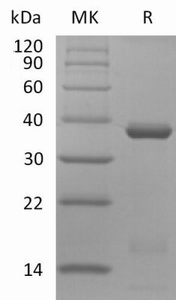| Cat.#: 12249 |
| Product Name: Human IL-15RAandIL-15 Complex (C-Fc) Protein |
| Size : 10 µg, 50 µg and 100 µg |
| Synonyms: IL-15 Receptor alpha and IL-15 Fusion Protein;IL15RAandIL15;IL15RAandIL15 Complex;Interleukin-15;IL-15;IL15 |
| Target: IL-15RAandamp;IL-15 |
| UNIPROT ID: P29459;P29460 |
| Description: Recombinant Human Interleukin-15 Receptor Alpha and Interleukin-15 Fusion Protein Complex is produced by our Mammalian expression system and the target gene encoding Ile31-Asp96andAsn49-Ser162 (Asn120Asp) is expressed with a Fc tag at the C-terminus. |
| Background: IL15RA is a high-affinity receptor for interleukin-15. Il15ra associates as a heterotrimer with the IL-2 receptor beta and gamma subunits to initiate signal transduction. It can signal both in cis and trans where IL15R from one subset of cells presents IL15 to neighboring IL2RG-expressing cells. Il15ra is expressed in special cells including a wide variety of Tand B cells and non-lymphoid cells.IL-15 is a cytokine that regulates T cell and natural killer cell activation and proliferation. IL-15 binds to the alpha subunit of the IL-15RA with high affinity. IL-15 also binds to the beta and gamma chains of the IL-2 receptor, but not the alpha subunit of the IL2 receptor. IL-15 is structurally and functionally related to IL-2. Both cytokines share some subunits of receptors, allowing them to compete for and negatively regulate each other's activity. The number of CD8 memory T cells is controlled by a balance between IL-15 and IL-2. Despite their many overlapping functional properties, IL-2 and IL-15 are, in fact, quite distinct players in the immune system. IL-15 is constitutively expressed by a wide variety of cell types and tissues, including monocytes, macrophages and DCs. The enhanced activity of the IL-15N72D:IL-15RaSu/Fc complex is likely the result of the increased binding activity of IL-15N72D to IL-15Rβγ c , optimized cytokine trans-presentation by the IL-15RaSu domain, the dimeric nature of the cytokine domain and its increased in vivo half-life compared to IL-15. These findings indicate that this IL-15 superagonist complex could serve as a superior immunostimulatory therapeutic agent. |
| Species/Host: HEK293 |
| Molecular Weight: 34.4and12.8 KDa |
| Molecular Characterization: Not available |
| Purity: Greater than 95% as determined by reducing SDS-PAGE. |
| Formulation & Reconstitution: Lyophilized from nanodisc solubilization buffer (20 mM Tris-HCl, 150 mM NaCl, pH 8.0). Normally 5% – 8% trehalose is added as protectants before lyophilization. |
| Storage & Shipping: Store at -20°C to -80°C for 12 months in lyophilized form. After reconstitution, if not intended for use within a month, aliquot and store at -80°C (Avoid repeated freezing and thawing). Lyophilized proteins are shipped at ambient temperature. |

Figure 1. Greater than 95% as determined by reducing SDS-PAGE. |











